
|

|

|


|
|
Blériot I
Blériot first ventured into aeronautical design between
1900 and 1902 when he built a series of model
"ornithopters"—aircraft propelled by flapping
wings—that were powered by carbon-dioxide engines. The
complex and heavy machinery needed to move their wings kept
these contraptions, like others of their ilk, entirely
earthbound. Even though they never flew, Blériot named
one of them after himself—the Blériot I.
|


|
|
Blériot II
In June 1905, Blériot watched from the shore as
25-year-old engineer Gabriel Voisin launched an experimental
float glider on the Seine. The craft was essentially a large
box kite mounted on two long floats. As a motorboat towed it
forward, Voisin maneuvered the "elevator" at the front of the
glider, and the glider soared skyward from the water.
Blériot immediately commissioned Voisin to build him a
glider but make its wings more curved—a change Voisin
warned against. Indeed, in its own test on the Seine in July
1905 (pictured here), the Blériot II was airborne for a
mere 100 feet before crashing into the water.
|
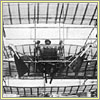

|
|
Blériot III
Far from discouraged by the crash of the Type II,
Blériot invited Voisin to join him in forming the
world's first airplane company. Their initial powered machine,
the Blériot III, had striking elliptical tandem wings
made of hollow ash covered with French silk. Twin elevators
were housed within the front wing, and a rudder was placed
inside the back wing. Blériot insisted upon a
24-horsepower, eight-cylinder engine to drive two large
tractor propellers at 600 rpm. The complex transmission
weighed 243 pounds. In May 1906, the plane was taken to Lake
Enghien near Paris for trials Voisin later called
"disastrous." It never left the lake's surface.
|
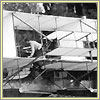

|
|
Blériot IV
Blériot replaced the forward elliptical wing of the
Type III with a box-kite biplane wing for his next model. In
front of this wing, he mounted a Wright-inspired biplane
elevator for pitch control. Behind the pilot seat, two
24-horsepower engines drove contrarotating propellers. The
entire craft weighed about 950 pounds. In this picture,
Gabriel Voisin prepares the plane for trials on Lake Enghien
in October 1906. It reached a cruising speed on the water of
nearly 20 mph, but like its predecessor, the Type IV never
lifted off. The next month, following another failed trial
with the Type IV, Blériot and Voisin dissolved their
partnership.
|
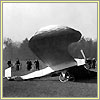

|
|
Blériot V
In November 1906, Blériot witnessed another aviator,
Alberto Santos-Dumont, fly 650 feet in a plane called the
14-bis, winning an Aero-Club de France prize. Inspired by the
14-bis, Blériot radically departed from his earlier
designs. His next model, called L'Oiseau (The Bird),
was a monoplane with strangely curved wings covered in vellum
paper. The cockpit was housed in a triangular fuselage. The
plane was to taxi and land on two standard bicycle tires, but
in test flights in March and April of 1907 it hopped more than
flew, and it crashed several times. (One crash is pictured
here.) Blériot, now piloting his planes himself,
emerged unscathed and still determined to fly.
|
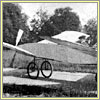

|
|
Blériot VI
Blériot would finally take to the skies in his next
aircraft, a tandem monoplane nicknamed The Dragonfly.
Louis Peyret, the foreman of Blériot's team, was
responsible for its design. The team hoped the plane's
upward-angled wings, with their large surface area, would
provide stability, but they still struggled with the control
problem. After unsuccessful tests in early July 1907, they
enlarged the wings shown in this picture. When Blériot
tried again in mid July, he managed flights of 100 and then
260 feet—hardly breaking records but reaching a critical
personal milestone. He enjoyed a few other short flights in
the precarious craft before destroying it in a crash on
September 17.
|
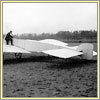

|
|
Blériot VII
Buoyed by his success with the Type VI, Blériot built
another monoplane. The wings of the Type VII spanned 36 feet
and tilted upward, though not at as sharp an angle as on
The Dragonfly. In his first trials, in November 1907,
Blériot barely got off the ground. (This picture shows
him climbing into the rectangular fuselage for one of the
first trials.) By early December, though, he had flown as far
as 547 yards, or over a quarter of a mile. On December 18, the
plane hit a hole upon landing and flipped on its back. Once
again, an aircraft was destroyed, but Blériot climbed
from the wreckage relatively unhurt.
|
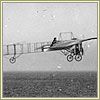

|
|
Blériot VIII
The Type VIII marked another turning point for Blériot.
This monoplane, built and repeatedly modified in 1908, looked
akin to its predecessor but had significant changes. Most
critically, it featured what would become the classic
Blériot cockpit controls—stick and rudder bar.
The "cloche," a bell-shaped piece of metal attached to the
control stick, operated lines leading to the elevators and
ailerons (the moveable parts of the wings). Blériot's
design was uniquely his own, and this airworthy plane allowed
him to refine his techniques as a pilot. (In this picture, he
soars over the field at Issy-les-Moulineaux in June or July
1908.) Blériot could now fly his first complete circles
and keep the plane aloft for eight minutes at a time.
|
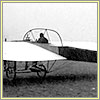

|
|
Blériot IX
By 1909, Blériot had touched the clouds, but it had
cost him dearly. He had squandered roughly
$150,000—including his wife's dowry—building his
flying machines. His next two models would take him to the
brink of financial ruin. The Type IX, powered by a
50-horsepower, 16-cylinder engine, weighed over 1,200 pounds,
considerably heavier than his previous monoplanes. It never
got off the ground.
|
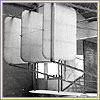

|
|
Blériot X
Blériot never even attempted test flights with the Type
X, the largest and heaviest aircraft he had developed to date.
Its wings spanned nearly 43 feet. The three-seat biplane was
an aberration from Blériot's line of monoplanes. Its
design was inspired by the Wright brothers' machines, but
unlike them, it never flew.
|
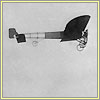

|
|
Blériot XI
Blériot called the next model one of his "last chance
monoplanes." He gambled that it would help him win the prize
money and sales he needed to stay solvent. The Blériot
XI was a small monoplane, primitive by today's standards, with
a wingspan of only 23 feet, an open box-frame fuselage that
exposed a pilot to the elements, and a three-cylinder,
25-horsepower engine. Blériot's bet with this little
plane paid off. In the five years following his Channel
crossing on July 25, 1909, he sold over 800 aircraft and
became the world's most successful airplane manufacturer. The
Blériot XI is now regarded as one of the great planes
of all time—both for what Blériot accomplished in
it and for the influence it had on the future of aviation. (In
this photo, children follow the landmark flight as
Blériot nears the English coast.)
|

|

|

